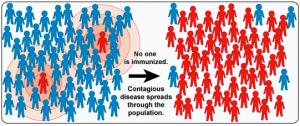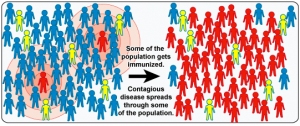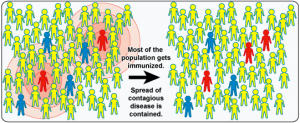Herd Immunity
Scenario #1: If no one is vaccinated against a disease

The people in blue above are healthy people who have not be vaccinated against a disease. Those in red are sick with a disease. When sick people enter a population of unvaccinated people, many of the healthy people become sick with the disease, as you can see on the right. When the disease has spread throughout the population we call it an outbreak.
Scenario #2: Some people are vaccinated against a disease, but not enough for herd immunity

When sick people (in red) enter a community with a few healthy vaccinated people (in yellow) and lots of healthy unvaccinated people (in blue), the chance of disease outbreak is also high. Those who are vaccinated will not get sick, but most of those who are unvaccinated become ill and spread the disease to others.
Scenario #3: A population with herd immunity

When a population has herd immunity, that means that most of it’s citizens are vaccinated against a disease (people in yellow). Those vaccinated people act as shields to block disease from spreading to those people who are unable to get vaccinated. When sick people (in red) enter a herd-protected community, the disease may spread to a few healthy unvaccinated people (in blue), but will not reach all of the healthy unvaccinated people. This type of community is ideal to the preventing the spread of contagious diseases.
Unfortunately, because more and more people are deciding not to vaccinate their children, the population is trending more towards scenario #2. If your child is vaccinated, he is protected. If you leave your child unvaccinated, your child may not be getting the benefits of herd immunity any longer. This is why certain diseases such as whooping cough, and measles are back on the rise. The only way to be sure your child doesn’t pick up a harmful, potentially life-threatening disease is to get him or her vaccinated.
References:
- Vaccine.gov www.vaccine.gov
- Photos courtesy of The National Institute of Allergy and Infectious Diseases (NIAID)
13 thoughts on “Herd Immunity”
Comments are closed.


Funny! Unfortunately, that’s not my forte.
Could you write about Physics so I can pass Science class?
There should now be a subscribe option on this blog. Thank you for reading!
Yes!
https://twitter.com/TheVaccineMom
Great!
Thank you for reading, I appreciate it! And of course you may 🙂
Yes!
https://twitter.com/TheVaccineMom
Very good post! We will be linking to this great post on our website. Keep up the good writing.
Good post. I learn something totally new and challenging on websites I stumbleupon on a daily basis. It’s always useful to read articles from other writers and use a little something from their websites.
Hey there! Do you use Twitter? I’d like to follow you if that would be okay. I’m undoubtedly enjoying your blog and look forward to new posts.
Thank you, I have recently been looking for info about this topic for a while and yours is the best I’ve discovered so far. However, what concerning the conclusion? Are you positive in regards to the source?
Simply want to say your article is as astonishing. The clarity in your post is just great and i could assume you are an expert on this subject. Well with your permission let me to grab your RSS feed to keep up to date with forthcoming post. Thanks a million and please continue the enjoyable work.
Another clear, well-written post, thank you.
One point of clarification: in the pre-vaccine era, the individuals with immunity would be those who had survived the disease.
If I had the graphics skills, I’d make up something like the image in scenario #3, with some of the yellow-colored people in black, to signify that they had died of the disease. This would be a lot, in the case of smallpox, and a non-trivial number, in the case of, say measles.